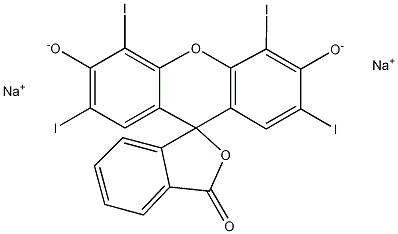
Structural formula
| Business number | 05TR |
|---|---|
| Molecular formula | C20H6l4Na2O5 |
| Molecular weight | 879.86 |
| label |
erythrosine, Erythrosine B sodium salt, Acid Red 51 FB, Reagents for histochemical research |
Numbering system
CAS number:568-63-8
MDL number:MFCD00144257
EINECS number:240-474-8
RTECS number:LM5950000
BRN number:None
PubChem number:24894685
Physical property data
1. Physical property data
1. Properties: red or reddish-brown granules or powder
2. Solubility: easily soluble in water, soluble in glycerin and ethanol, insoluble in fat
3. Melting point:303℃
Toxicological data
None yet
Ecological data
None yet
Molecular structure data
None yet
Compute chemical data
4. Computational Chemistry Data:
2. Number of hydrogen bond donors:0
3. Number of hydrogen bond acceptors:5
4. Number of rotatable chemical bonds:1
5. Topological molecular polar surface area (TPSA):89.5
6. Number of heavy atoms:31
7. Surface charge: 0
8. Complexity:797
9. Number of isotope atoms: 0
10. Determine atomic configuration Number of centers:0
11. Uncertain atomic Number of structural centers:0
12. Determine the chemical bond configuration Number of centers:0
13. Uncertain chemical bonding Number of structural centers:0
14. Number of covalent bond units: 3
Properties and stability
1. Basic properties:
Red or reddish-brown granules or powder. Easily soluble in water, soluble in glycerol and ethanol, insoluble in fat. It has poor light resistance, good heat resistance, alkali resistance, redox resistance and bacterial resistance, but is unstable to acid.
Storage method
None yet
Synthesis method
2. Preparation method:
Originated from iodination of fluorescein. Resorcinol, phthalic anhydride and anhydrous zinc chloride are heated and melted to obtain crude fluorescein. After the crude fluorescein is refined with ethanol, it is dissolved in sodium hydroxide solution, and iodine is added for reaction. Add hydrochloric acid to precipitate crystals, then convert them into sodium salt and concentrate them.
Purpose
3. Purpose:
This product can be used alone or in combination with other food colorings for a variety of foods such as cakes, agricultural and aquatic products processing (cherries, fish cakes, Zhenjin Babao pickles). my country’s hygienic standards for the use of food additives (GB2760-86) regulations, bright red The maximum usage amount in food is0.05g/kg. In addition, the product is also used as a pigment in drugs and cosmetics. Oral administration to ratsLD50for1900mg/kg, the Food and Agriculture Organization of the United Nations and the World Health Organization stipulate that a person’s daily allowable intake (ADI) is0-1.25mg/kg.

 微信扫一扫打赏
微信扫一扫打赏

